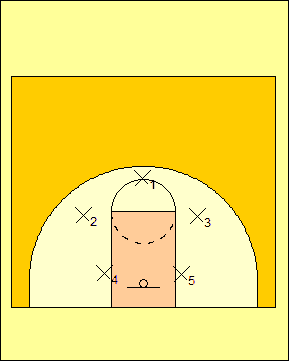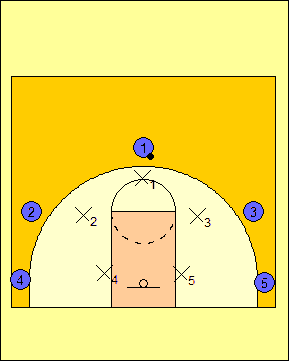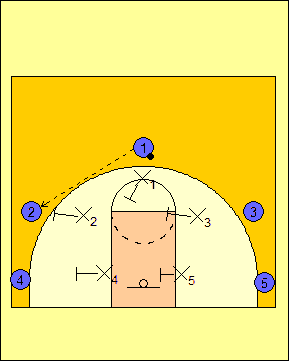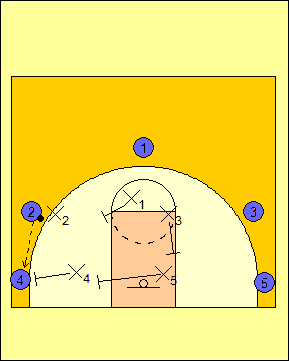
Basketball Coaching DVD's at Championship Productions
1-2-1 (3-2) ZONE DEFENSE AND HALF COURT TRAP
When I was a graduate assistant at Rockhurst University for Bill O'Connor, we
had success with our 1-2-2 zone defense. While this was not our primary
defense, we were successful in running the defense as a change-of-pace defense
to force teams to shoot from the perimeter with greater frequency.
I have also seen several other teams have great success with press defenses in
the half court and in three-quarter court using the 1-2-2 alignment. These
presses are effective in forcing the ball to one side of the floor and getting
traps near the half court line in the area of the sideline.
Advantages of the 1-2-2 (3-2) Zone Defense and Half Court Trap
The zone has several advantages that should be taken into consideration when a
coach wishes to utilize the 1-2-2 zone defense. They include, but are not
limited to:
-
Adaptability to personnel. The 1-2-2
zone defense can be used with three guards and two posts or two
guards and three posts. I will present an adjustment you can
make to take advantage of your personnel if you have three forwards
and two guards.
-
Coverage of the point, wings and low post.
If you are playing a team that likes to run a three-out/two-in
offense with a point guard, two wings and two low posts, the 1-2-2
zone defense can be an effective neutralizer.
-
Ability to extend the defense. The
1-2-2 zone defense has the natural ability to be extended into a
pressing defense. Because of this, you are able to play more
defenses that attack the other team's offense. This will be
discussed more in-length later in this article.
-
Ability to dictate where your players will
defend. If you have defensive players you do not want
guarding near your basket, the 1-2-2 zone allows you to hide them
from playing post defense. All you have to do is put your
players where you feel they are best suited to play defense instead
of having to determine a defensive match-up for each player.
-
The zone is an attractive defense to start the
fast break. Because of the alignment of a point and two
wings at the top of the zone, the formation of the defense is a
great way to get players into their lanes and attack the basket with
a three-man fast break and both posts trailing.
Disadvantages of the 1-2-2 (3-2) Zone Defense and Half Court Trap
However, there are also some disadvantages that need to be considered
before deciding to use the 1-2-2 zone defense. They include, but
are not limited to:
-
Inability to cover the middle of the lane.
Because the manpower of the defense is prepared to guard the point,
wings, corners and posts, the middle of the zone becomes and
inviting target for the offense. If the ball is passed into
the lane area from above the free-throw line extended, the defense
needs to know who is responsible for covering the area. Later
in this article, I will discuss how the defense can cover the void
in the middle of the zone.
-
Like all zones, the offense can dictate the
match-ups. The offense can create mismatches by putting
relatively weak defensive players against relatively strong
offensive players. Also, the offense can dictate where
particular personnel can be set up against the defense. When
this happens, the zone really cannot adjust and the defense is
caught in a bind.
-
Like all zones, your players must either be quick
or long with a preference for both. Slow and short teams
typically do not play great zone defense because they are not able
to cover ground quickly. Zones are advantageous for long and
quick teams because they can shrink the size of the gaps in the zone
better than shorter and slower players. Because of this, teams
with length and quickness prosper more in running a zone defense
than those that are not.
-
Zone defenses are relatively passive in nature.
Because the zone is designed to be packed inside the three-point
arc, the defense is not looking to actively steal perimeter passes.
While some passes might be intercepted, the zone is not a great way
to force turnovers. Instead, the zone is designed to control
the action from inside the three-point line and force several long
shots.
Setting Up the Defense
We will start by putting X4 and X5 on the low blocks and they will be primarily
responsible for protecting the low post area. On occasion, we will ask
them to guard the ball in the corners. However, their chief role in the
defense will be to prevent the ball from going into the low post area.
We will then place X2 and X3 at the wings of the zone. These two players
will guard the wings and work to prevent the ball from going into the high post
area. We do not want the ball to go to the elbows from the point as much
as possible. We also have rules for X2 and X3 when the ball is skipped
above the free-throw line extended from the other side of the floor which we
will detail later in the article.
We place X1 at the top of the free throw circle. Since X1 will be the
person most responsible for a fast break, we want to put him up near the top of
the zone along with X2 and X3. We also have rules for skip passes as it
relates to X1 that will be mentioned later in the article as well as the rules
for skip passes regarding X2 and X3.
If you are playing with three forwards, you can still run this offense by
putting X3 at the point and X1 and X2 at the left and right wings respectively.
|

Diagram 1 |
1-2-2 (3-2) Zone Defense Slides
Diagrams 2-4 illustrate the slides of the 1-2-2 zone. X1 guards the ball
in the the point area, X2 and X3 will cover the ball when it is at the wing and
X4 and X5 guard the ball when it is passed to the corner. This is only
done when there are no skip passes made to move the basketball. Whenever
the defense brings the ball across half court, we will not get into our slides
until the first pass is made.
|

Diagram 2 |

Diagram 3 |
|

Diagram 4 |
Read the full article and many others by signing up for a Coach Peel
Basketball membership today.
Membership Subscription with Monthly Payments: $6.00 per
month
Membership Subscription with Quarterly Payments:
$15.00 per quarter (save over 16.6%)
Membership Subscription with Annual Payments: $50.00 per
year (save over 30.5% & get your first 30 days free!)

© 2010-2017 Alan Peel Enterprises